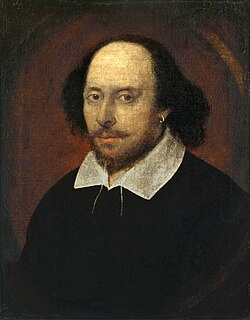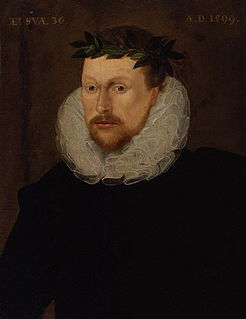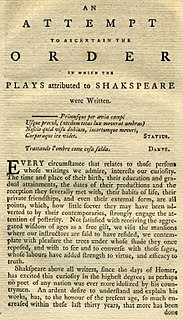Related Research Articles

Christopher Marlowe, also known as Kit Marlowe, was an English playwright, poet and translator of the Elizabethan era. Modern scholars count Marlowe among the most famous of the Elizabethan playwrights and based upon the "many imitations" of his play Tamburlaine they consider him to have been the foremost dramatist in London in the years just before his mysterious early death. Some scholars also believe that he greatly influenced William Shakespeare, who was baptised in the same year as Marlowe and later became the pre-eminent Elizabethan playwright. Marlowe was the first to achieve critical notoriety for his use of blank verse, which became the standard for the era. His plays are distinguished by their overreaching protagonists. Themes found within Marlowe's literary works have been noted as humanistic with realistic emotions, which some scholars find difficult to reconcile with Marlowe's "anti-intellectualism" and his catering to the taste of his Elizabethan audiences for generous displays of extreme physical violence, cruelty, and bloodshed.

William Shakespeare was an English playwright, poet, and actor, widely regarded as the greatest writer in the English language and the world's greatest dramatist. He is often called England's national poet and the "Bard of Avon". His extant works, including collaborations, consist of some 39 plays, 154 sonnets, two long narrative poems, and a few other verses, some of uncertain authorship. His plays have been translated into every major living language and are performed more often than those of any other playwright. They also continue to be studied and reinterpreted.

King Lear is a tragedy written by William Shakespeare. It tells the tale of a king who bequeaths his power and land to two of his three daughters, after they declare their love for him in a fawning and obsequious manner. His third daughter gets nothing, because she will not flatter him as her sisters had done. When he feels he has been treated with disrespect by the two daughters who now have his wealth and power, he becomes furious to the point of madness. He eventually becomes tenderly reconciled to his third daughter, just before tragedy strikes her and then the king.

Michael Drayton was an English poet who came to prominence in the Elizabethan era.
This article contains information about the literary events and publications of 1598.
Philip Henslowe was an Elizabethan theatrical entrepreneur and impresario. Henslowe's modern reputation rests on the survival of his diary, a primary source for information about the theatrical world of Renaissance London.
Anthony Munday was an English playwright and miscellaneous writer. He was baptized on 13 October 1560 in St Gregory by St Paul's, London, and was the son of Christopher Munday, a stationer, and Jane Munday. He was one of the chief predecessors of Shakespeare in English dramatic composition, and wrote plays about Robin Hood. He is believed to be the primary author of Sir Thomas More, on which he is believed to have collaborated with Henry Chettle, Thomas Heywood, William Shakespeare, and Thomas Dekker.

King Leir is an anonymous Elizabethan play about the life of the ancient Brythonic king Leir of Britain. It was published in 1605 but was entered into the Stationers' Register on 15 May 1594. The play has attracted critical attention principally for its relationship with King Lear, Shakespeare's version of the same story.

This article presents a possible chronological listing of the composition of the plays of William Shakespeare.

The Shakespeare apocrypha is a group of plays and poems that have sometimes been attributed to William Shakespeare, but whose attribution is questionable for various reasons. The issue is separate from the debate on Shakespearean authorship, which addresses the authorship of the works traditionally attributed to Shakespeare.
Robert Wilson, was an Elizabethan dramatist who worked primarily in the 1580s and 1590s. He is also believed to have been an actor who specialized in clown roles.

Sir Thomas More is an Elizabethan play and a dramatic biography based on particular events in the life of the Catholic martyr Thomas More, who rose to become the Lord Chancellor of England during the reign of Henry VIII. The play is considered to be written by Anthony Munday and Henry Chettle and revised by several writers. The manuscript is particularly notable for a three-page handwritten revision now widely attributed to William Shakespeare.
Robert Davenport was an English dramatist of the early seventeenth century. Nothing is known of his early life or education; the title pages of two of his plays identify him as a "Gentleman," though there is no record of him at either of the two universities or the Inns of Court. Scholars have guessed that he was born c. 1590; if, as some scholars think, he wrote the Address "To the knowing Reader" in the first quarto of King John and Matilda, he was still alive in 1655. He enters the historical record in 1624, when two of his plays were licensed by the Master of the Revels.

Elizabethan literature refers to bodies of work produced during the reign of Queen Elizabeth I (1558–1603), and is one of the most splendid ages of English literature.
The Admiral's Men was a playing company or troupe of actors in the Elizabethan and Stuart eras. It is generally considered the second most important acting troupe of English Renaissance theatre.
Fair Em, the Miller's Daughter of Manchester, is an Elizabethan-era stage play, a comedy written c. 1590. It was bound together with Mucedorus and The Merry Devil of Edmonton in a volume labelled "Shakespeare. Vol. I" in the library of Charles II. Though scholarly opinion generally does not accept the attribution to William Shakespeare, there are a few who believe they see Shakespeare's hand in this play.
Siôn Cent, was a Welsh language poet, and is an important figure in Medieval Welsh literature.
The Downfall of Robert Earl of Huntingdon and The Death of Robert Earl of Huntingdon are two closely related Elizabethan-era stage plays on the Robin Hood legend, that were written by Anthony Munday in 1598 and published in 1601. They are among the relatively few surviving examples of the popular drama acted by the Admiral's Men during the Shakespearean era.

Pasquill is the pseudonym adopted by a defender of the Anglican hierarchy in an English political and theological controversy of the 1580s known as the "Marprelate controversy" after "Martin Marprelate", the nom de plume of a Puritan critic of the Anglican establishment. The names of Pasquill and his friend "Marforius", with whom he has a dialogue in the second of the tracts issued in his name, are derived from those of "Pasquino" and "Marforio", the two most famous of the talking statues of Rome, where from the early 16th century on it was customary to paste up anonymous notes or verses commenting on current affairs and scandals.
Edward White was a London printer and stationer whose career spanned a period of over forty years. His shop in the booksellers' district of St Paul's Churchyard was at the Sign of the Gun, where he sold many anonymous works as well as works by Thomas Kyd, Robert Greene, Anthony Munday and Christopher Marlowe. Between 1594 and 1611 he sold all three quartos of William Shakespeare's Titus Andronicus.
References
- ↑ Shapiro, I. A. "The Significance of a Date" in Shakespeare Survey 8 (1955), 100-5.
- ↑ Knutson, Roslyn, ed. (2013). "Wise Man of West Chester, The". Lost Plays Database. Washington, D.C.: Folger Shakespeare Library. Retrieved 2019-05-22.
- ↑ Wiggins, Martin; Richardson, Catherine, eds. (2013). "866. John a Kent and John a Cumber". British Drama 1533–1642: A Catalogue. 3. London, UK: Oxford University Press. pp. 53–56. ISBN 978-0-19-926573-2.
| This article on a play from the 16th century is a stub. You can help Wikipedia by expanding it. |